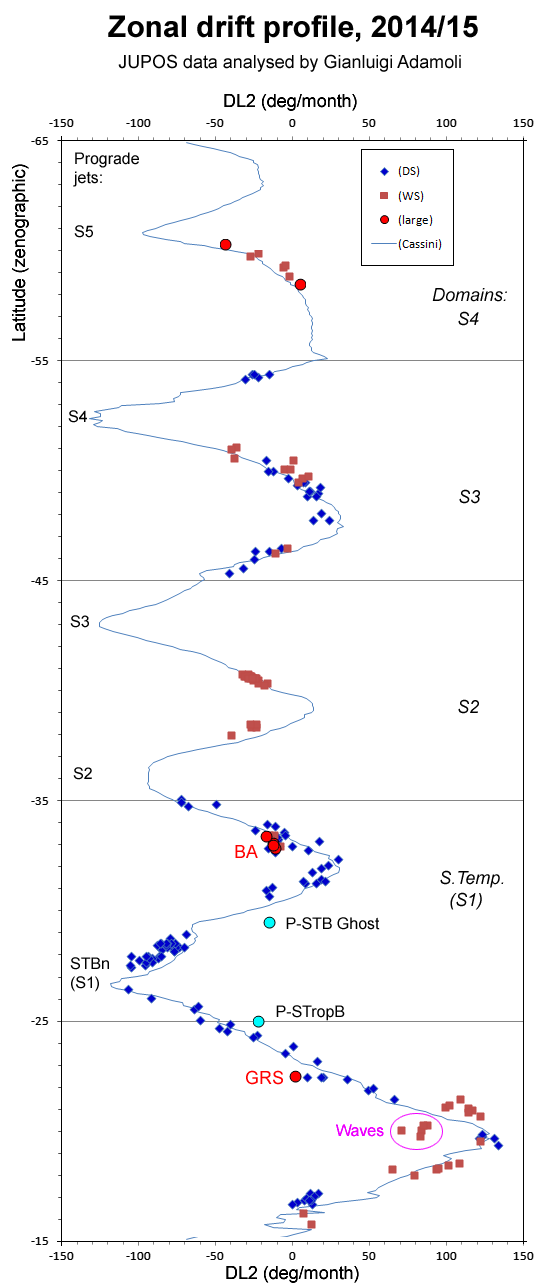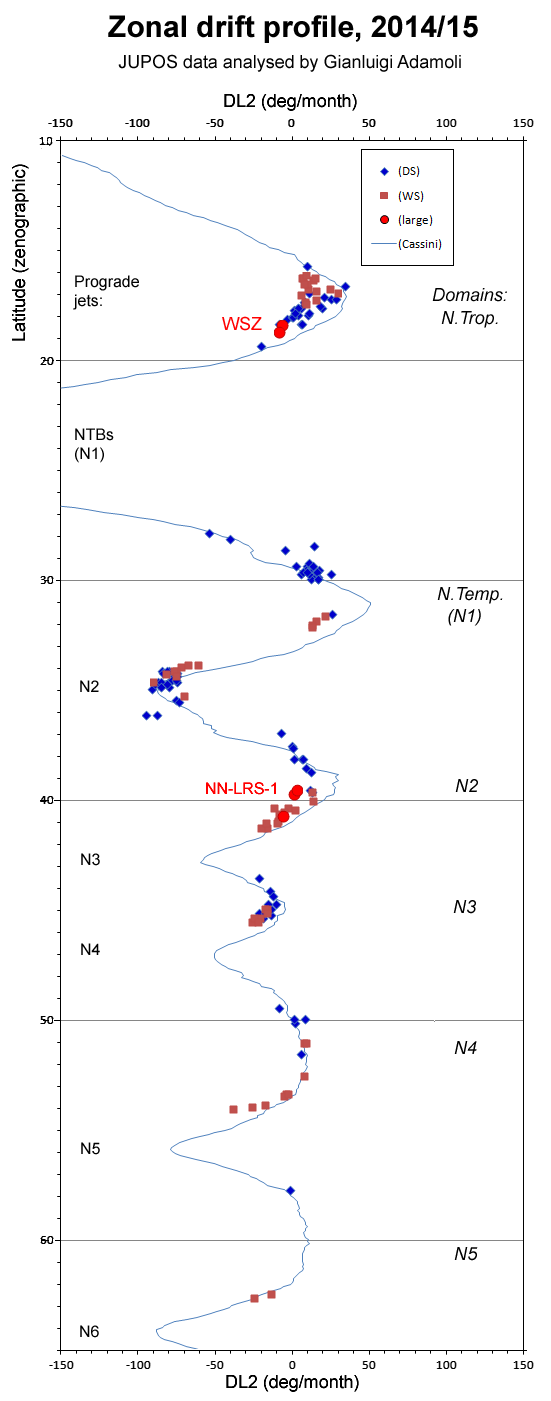|
January 29, 2016
John Rogers (British Astronomical Association)
| ||
|
Japanese (translated by Yuichi Iga)
Greetings, Jupiter enthusiasts.
I am pleased to tell you that we have posted a full report on Jupiter in the 2014/15 apparition, which can be found at:
This is report no.12, and the list of observers is posted separately as report no.11.
best wishes,
January 26, 2016 with data from the JUPOS team (GA, Michel Jacquesson, Marco Vedovato, Hans-Joerg Mettig, & Grischa Hahn)
Summary
Separate reports are posted for the S. Temperate domain (which included oval BA and dark spots associated with it, the STB Ghost, and a continuing outbreak of STBn jet spots), and for the SEBs (which exhibited a distinctive wave pattern). The NEBs carried 7-9 typical large dark formations, with irregular spacing, drifting at DL1 ~ +9 deg/month. Some smaller features had DL1 ~ -16 deg/month.
Two substantial NEB rifts developed in 2014 Sep-Oct., near white spot Z; they had slower drift rate than most NEB rifts. They expanded over subsequent months. There were no persistent features on NEBn except white spot Z. Anticyclonic ovals (white or reddish) were tracked in all domains from S4 to S0 and from N0 to N5. As usual, those in high-latitude domains (S4, S3, N2, N4) (all of which included long-lived ovals) were subject to oscillations and sudden changes in drift rates. Retrograding dark spots were also detected in these four domains. Zonal drift profiles (ZDPs) were well defined, although curiously, the ZDP from the NTropZ to the N3 domain appeared to be 0.4 to 0.8 deg. further south than usual. Prograde jet speeds were defined for the S2, S1, N2, and equatorial jets. The speed tables will be useful for predicting drifts of features during the Juno mission in 2016-2017.
 Fig.1: Hi-res map of the planet on 2015 March 5-6, made by Marco Vedovato, mainly from images by C. Go & T. Olivetti. Major features are labelled. (Polar projections of the same map are in Figs.5 and 18.)
Fig.10 (L): ZDP for the southern hemisphere; Fig.11 (R): ZDP for the northern hemisphere, with Cassini ZWP [from Ref.22] for comparison.
| ||
|
_______________________________ John H. Rogers, Ph.D. Jupiter Section Director, British Astronomical Association jrogers11@btinternet.com http://www.britastro.org/jupiter/ _________________________________
| ||
|
Report on Jupiter in 2014-15
2016年1月29日
John Rogers (British Astronomical Association) こんにちは、木星愛好家の皆さんへ、
私は、以下のリンクで見られる、木星の2014/15年観測期のフルレポートを公開したことを伝えられてうれしく思う。
これはno.12のレポートで、観測者リストはno.11として別に公開している。 John
Jupiter in 2014/15: Final numerical report 2016年1月26日 with data from the JUPOS team (GA, Michel Jacquesson, Marco Vedovato, Hans-Joerg Mettig, & Grischa Hahn)
サマリー
別のレポートで南温帯地域(これに関係した白斑BAと暗斑、STB Ghost、STBnジェット気流暗斑の連続放出を含む)とSEBs(独特な波パターンを示す)に関して公開している。 NEBsには、DL1=約+9度/月でドリフトし不規則な間隔で、7-9個の典型的な暗い形成物(フェストーン)があった。いくつかの小さい模様はDL1=約-16度/月を示した。
2個の重要なNEBリフトが2014年9-10月に白斑Zの近くで発達した。それらは多くのNEBリフトよりは遅いドリフトだった。それらはその後数ヶ月に渡って拡張した。白斑Zを除いてNEBnに継続する模様はなかった。 高気圧性白斑(白か赤味がかった)はS4からS0までとN0からN5までの全ての地域で追跡された。通常は、高緯度地域(S4,S3,N2,N4)の白斑(長寿命の白斑を含む全て)は振動とドリフトの突然の変化を受けやすい。後退暗斑もこれらの4個の地域で検出された。 不思議にも、北熱帯からN3地域までの東西ドリフトプロファイル(Zonal drift profiles (ZDPs))は通常よりはかなり南の0.4〜0.8度に思われるけれども、ZDPは良く定義された。前進ジェット気流の速度はS2,S1,N2と赤道ジェット気流について定義された。速度テーブルは2016-2017年のJunoミッションで模様のドリフトを予測するのに役に立つだろう。
 図1:2015年3月5-6日の高解像度マップ、主にC. Go & T. Olivettiの画像から、Marco Vedovato作成。主要な模様にラベルを入れている(同じマップの極投影は図5と図18である)。
図10 (L): 南半球のZDP。 図11 (R): 北半球のZDPと比較のためのCassini ZWP [文献22から]。
| ||
|
_______________________________ John H. Rogers, Ph.D. Jupiter Section Director, British Astronomical Association jrogers11@btinternet.com http://www.britastro.org/jupiter/ _________________________________
| ||
|
【日本語訳:伊賀祐一 (Yuichi Iga)】 |

